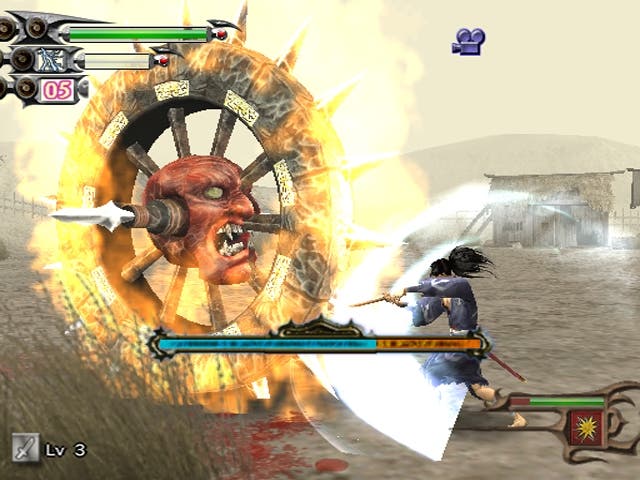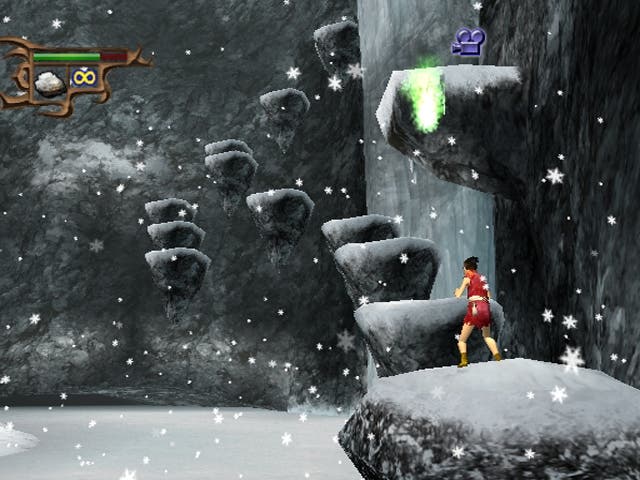Blood Will Tell
Sega's latest has swords for arms, fake eyes and all manner of other unusual body parts. Naturally he's going to have to butcher some demons if he wants the real ones back.
"You always have to take things one step too far." We've probably all heard that at one point or another, right? And some of us have probably learnt from it. Those of us who didn't, however, now most likely write fantasy novels and comic books. Indeed, judging by the latest of his creations to make the transition to videogame form, Astro Boy creator and sadly departed manga artist Osamu Tezuka quite possibly adopted it as something of a mantra. It is after all one thing to play around with the idea of cybernetic limbs, prosthetics and implants, but in the case of Hyakkimaru, star of Blood Will Tell, Tezuka has swapped out just about every organ and extremity that might have blood coursing through it, sticking swords and guns where arms should be and plenty more besides. The goal? Well, Hyakkimaru wants his real bits back, and he's not going to get far as skin wrapped around a few IOU notes. It's a lot like Pinocchio in that regard, except with a lot more demon slaughter and brain-mushing violence. Tsk. There we go taking things too far again.
He's Got No Strings...

Naturally there is a reason for Hyakkimaru's rather bizarre pseudo-biological make-up - other, that is, than Tezuka's desire to give us a dramatically different protagonist to get involved with. Hyakkimaru's plight is actually the fault of his father, whose lust for power led him to enter into a pact with a group of demons, who offered him immense power in exchange for his first born child. When Hyakkimaru was finally born, he was abandoned and the demons picked him apart. Except, instead of wilting away in a pool of unwanted organics following this demonic frenzy, he was rescued by a benevolent inventor who set about rebuilding this unwanted child and training him in the ways of the samurai. Now a fully grown almost-man and kitted out with all manner of augmentations, Hyakkimaru is on a quest to defeat the 48 demons that hold the various keys to his humanity, and it's at this point that the player is thrust into his shoes and let rip on all manner of Japanese mythology.
It's an interesting premise, however convoluted, and it makes for some spectacular action. It also changes the dynamic somewhat - after all, as the product of some fine engineering, surely he's a lot more powerful than the average upstart, and his journey to reclaim the bits of himself the demons stole seems more like a gradual dilution of his powers than the traditional path of gradual improvement. But fortunately for Hyakkimaru (and indeed the player), developer Wow has been quite clever in the way it handles this seemingly backwards progression. Initially, for example, the in-game tutorial and the whole of the first and second levels are set in black and white - it's only when Hyakkimaru regains one of his eyes in a battle with the second of his demon foes that we're all finally able to see in colour. As he gathers more and more body parts, his abilities actually improve, replacing brute force in some areas with tactical refinement. With his real arms, for example, he benefits from a better reach in close quarters, and latter attachments allow him to do things like recover from falls at greater speed, rather than labouring over them as he does to begin with.
Building Blocks

He is nevertheless quite a veritable weapon right from the outset. Apart from the requisite ninja sword, the player can toggle his fake arms on and off, revealing a pair of delicately crafted blades with which he can swirl around like a spinning top and devastate hordes of demonic adversaries. He can also kneel down and fire looping explosive rounds out of one of his kneecaps, using the left analogue stick to change the trajectory and triangle to fire. With these tools at hand and the usual analogue movement, strafing and circling abilities, early combat feels pretty immediate and gratifying. Square and triangle amount to different slash-style attacks, and string naturally together to form various impromptu combinations, including one that sees him pirouetting upside down like a top, cutting through swathes of enemies like a hedge trimmer going at the verge.
Hyakkimaru can also charge up a powerful attack by holding triangle, and cleverly it's the player's job to keep the furious onslaught going once it's unleashed, by tapping face buttons in a sequence that appears along the bottom of the screen. Failing to keep up with these prompts breaks up the attack. Managing to do so effectively can be a deadly alternative to wading in mashing square and triangle. Of course, it's not all melee combat either - it chews up resources like nobody's business, but if the player really can't find an opportunity to unleash the blades in close quarters, Hyakkimaru can also fall back on an arm-stump-mounted machine gun, which is a comfort when he's low on health.
In addition to all of that, Hyakkimaru also has a sort of spirit charge bar, which fills up as he conquers more and more of the 48 demons' minions. And when it's finally full, pressing square and triangle together unleashes a ferocious attack that does far more damage than anything else - and sees him twirling again, this time the power of his attack allowing him to swing his blades in a circle with a much greater circumference. Anything that happens to be in his path - which you can control with the left stick - is sliced and diced like vegetables in a blender, cut so fine that death animations are practically superfluous. It's certainly useful when it comes to fighting the 48 demons themselves.
Demon Siege

As you might imagine, each of the 48 actually constitutes a boss encounter. Each of these seems to take place in a larger circular sort of arena, with the camera locked on to the demon throughout. What's more, each goes through several phases of health bar before they finally succumb and cough up whichever body part they happen to be holding on to, and their attack patterns are varied but more or less obvious enough that you can beat them efficiently once you've grasped their subtleties. Obviously we haven't seen too many of them yet, but we've already toppled a nasty humanoid gargoyle who towers over Hyakkimaru, and stomps and flaps around with devastating consequences, as well as some of his less forgiving mates.
Fortunately, Hyakkimaru has some help in dealing with these monsters thanks to Dororo, a young girl he encounters halfway through one of the first levels in the game. Having spotted him reattaching his fake right arm, she declares that she's a master thief and promises that one day she will have the sword in his arm. After a nasty riverbed encounter, however, she gives up on that - at least for the time being - and instead sets about helping our hero in his task, slashing at mutual enemies and generally fending for herself. Far from a hindrance in fact, her presence is often quite beneficial - she can be directed to attack opponents and retrieve items, according to the developer, and we understand that we'll even be able to control her at some stage to perform tasks that Hyakkimaru is unable to complete by himself.
Time Will Tell

All limbs considered, Blood Will Tell certainly has some potential. The narrative alone is intriguing, and - although we were told that many of the menus, cut-scenes and indeed graphics in general were subject to possible change - it's presented in quite an unusual way through a mixture of CG sequences, and tapestry-like between-level cinematics which vary greatly in graphical style.
There are a few little worries at this stage, admittedly, including a camera locked to L1 rather than on the right analogue stick, which sometimes has difficulty keeping track of many enemies at once. But with the game now due out in early 2005, there's plenty of time to do the obvious things like adjusting the camera, the difficulty curve, and settling on some more varied mission structures - for now, it's very much a case of slashing and blasting your way through levels fall of smaller demons before taking on a boss and then repeating the process.
Those issues aside though, we reckon Blood Will Tell could be worth keeping an eye on - implant or otherwise. With plenty of huge boss encounters on the cards later on, a satisfying set of abilities and an interesting premise, it's a couple of razor cuts above the usual third-person slasher, and we're certainly keen to see whether Sega can match Tezuka's ambition by taking a few steps beyond the bounds of our expectations.
Blood Will Tell is due out on PS2 in early 2005.

